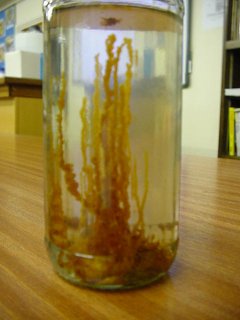silicate

Crystal garden grown using water glass. Image credit: S. Horbury.
A silicate is any salt of silicic acid. All silicates contain silicon, oxygen, and one or more metals, and may contain hydrogen. Discrete silicate anions (negative ions) include orthosilicates (SiO4–4), metasilicates (SiO32–), and groups of SiO4 units linked by Si–O–Si bonds; such condensation also produces infinite anions in chains, layers, or three-dimensional arrays.
Silicates (including aluminosilicates) are the largest and most important group of rock-forming minerals, making up more than 90% of the Earth's crust. The SiO4 units may form single or double chains (as in pyroxene or amphibole), sheets (as in mica), rings (as in beryl), or ionic bonds to a metal (as in olivine). Silicate minerals, such as feldspars, garnet, and mica.
Glass is a mixture of silicates with small amounts of other substances. Sodium silicates are used in adhesives and in the production of detergents. Quartz (SiO) is usually regarded as a silicate mineral.
Water glass
Water glass is an aqueous solution of sodium silicate (Na2SiO3) – a concentrated, syrupy alkaline – made by fusing sodium carbonate with silica. It is used to preserve eggs, as a cement, in ore flotation, and for water- and fire-proofing.
Water glass can also be used to grow "crystal gardens." Crystals of various colored metal salts, such as copper sulfate, iron sulfate, and iron chloride are added to a jar containing a 50% solution of water glass. The corresponding metal silicates are formed as structures that resemble alien plants.


